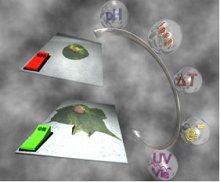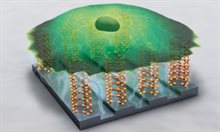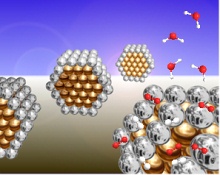Currently, our efforts are focused on four major areas:
- Diagnostic molecular-based technologies
- Switchable biological surfaces
- Intracellular nanoscale sensors
- Novel nano-electrocatalysts for proton exchange membrane fuel cells
Diagnostic molecular-based technologies
One of the most common post-translational modifications of proteins is glycosylation, the process by which short sugar chains are selectively added to specific protein residues, resulting in a huge number of glycoprotein variants (glycoforms). There is now overwhelming evidence that glycosylation changes during the development and progression of various malignancies such as cancer, immune deficiencies, neurodegenerative diseases, hereditary disorders and cardiovascular diseases. Many clinical biomarkers in cancer are glycoproteins and since glycoproteomics is rapidly emerging as an important technique for biomarker discovery, glycoproteins are expected to become increasingly important to the diagnosis and management of human diseases.
Currently, antibodies are playing a central role in enabling the detection of glycoprotein biomarkers using a variety of immunodiagnostic tests. Nonetheless, antibodies do have their own set of drawbacks that limit the commercialisation of antibody sensing technology. They suffer from poor stability, need special handling and require a complicated, costly production procedure. More importantly, they lack specificity because they bind only to a small site on the biomarker (i.e. epitope) and are not able to discriminate, for instance, among different glycosylated proteins. The current antibody diagnostic technology has well recognized limitations regarding their accuracy and timeliness of diagnose of disease.
 Our research aims at developing generic, robust, reliable and cost-effective alternatives to antibody technology. The group is developing synthetic recognition platforms with high sensitivity and specificity for glycoproteins. Our synthetic platforms are providing new opportunities in the diagnosis of the diseases, i.e. diseases that so far have been impossible to diagnose at early stages, where the long term survival is the highest.
Our research aims at developing generic, robust, reliable and cost-effective alternatives to antibody technology. The group is developing synthetic recognition platforms with high sensitivity and specificity for glycoproteins. Our synthetic platforms are providing new opportunities in the diagnosis of the diseases, i.e. diseases that so far have been impossible to diagnose at early stages, where the long term survival is the highest.
Switchable Biological Surfaces
The development of surfaces that have switchable properties, also known as smart surfaces, have been actively pursued in the past few years. The recent surge of interest in these switchable systems stems from the widespread number of applications to many areas in science and technology ranging from environmental cleanup to data storage, micro- and nanofluidic devices.
Moreover, the ability to modulate biomolecule activity, protein immobilisation, and cell adhesion, at the liquid-solid interface is important in a variety of biological and medical applications, including biofouling, chromatography, cell culture, regenerative medicine and tissue engineering.
Our group is developing novel stimuli-responsive surfaces for real-time, reversible controlling of activity of biomolecules with different biological functions, size and structure on macroscopic surfaces.
The goal is to precisely control the physical, chemical and, in particular, the biological properties of the surfaces from the molecular level and be able to change or tune in a well-defined and predictable manner such properties by using an external stimulus.
Intracellular nanoscale sensors
 Achieving direct interconnection of cells to an external platform through integrated nanomaterials holds great opportunities to stimulate and analyse cellular processes, occurring inside cells, across membranes, and between neighbouring cells all with high spatial and temporal resolution. Developments in microscopy techniques and fluorescent probe technology have enabled the imaging of dynamic processes such as protein translocation and protein-protein interactions with single molecule sensitivity, leading to profound insights into the movement of proteins and their interactions in living cells.
Achieving direct interconnection of cells to an external platform through integrated nanomaterials holds great opportunities to stimulate and analyse cellular processes, occurring inside cells, across membranes, and between neighbouring cells all with high spatial and temporal resolution. Developments in microscopy techniques and fluorescent probe technology have enabled the imaging of dynamic processes such as protein translocation and protein-protein interactions with single molecule sensitivity, leading to profound insights into the movement of proteins and their interactions in living cells.
However, in order to explain the intricate processes underlying cellular function a greater number of high spatial and temporal resolution tools are necessary to that can not only monitor a broad range of chemical and physical properties but can also modulate them at well-defined sub-cellular locations (e.g. cytoplasm, nucleus, mitochondria). We are addressing this need by developing highly sensitive and selective sensing platforms based on carbon nanotubes that can electrochemically communicate with the internal environment of cells.
Novel nano-electrocatalysts for proton exchange membrane fuel cells
 The use of costly and rare platinum(Pt)-based catalysts for PEMFC electrodes currently presents a significant barrier to the deployment and widespread commercialisation of this technology for automotive and domestic applications.
The use of costly and rare platinum(Pt)-based catalysts for PEMFC electrodes currently presents a significant barrier to the deployment and widespread commercialisation of this technology for automotive and domestic applications.
In addition to their prohibitive cost, the lack of long-term performance of platinum(Pt)-based catalysts has motivated major research efforts in the development of superior alternatives. We are currently using wet-chemical synthesis to develop low-cost, high performance nano-electrocatalysts for PEMFC.
Through our work we hope to make significant progress towards meeting targets for reduced platinum group metal loading and improved lifespan of PEMFC systems which in turn, are crucial steps towards commercial deployment and viability in the automotive and domestic markets.